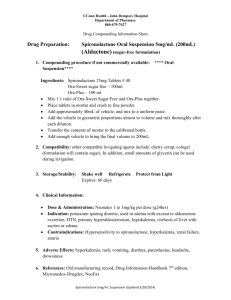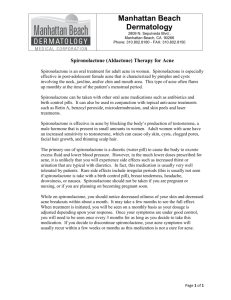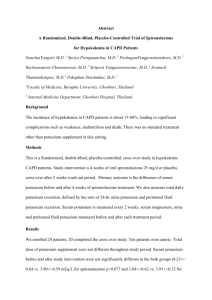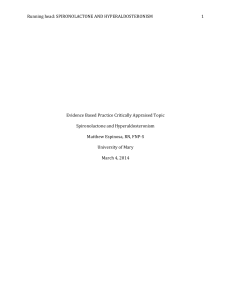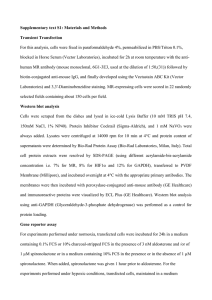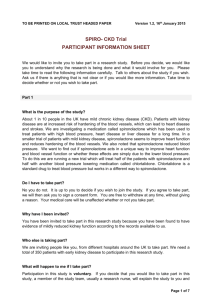Document 13309385
advertisement
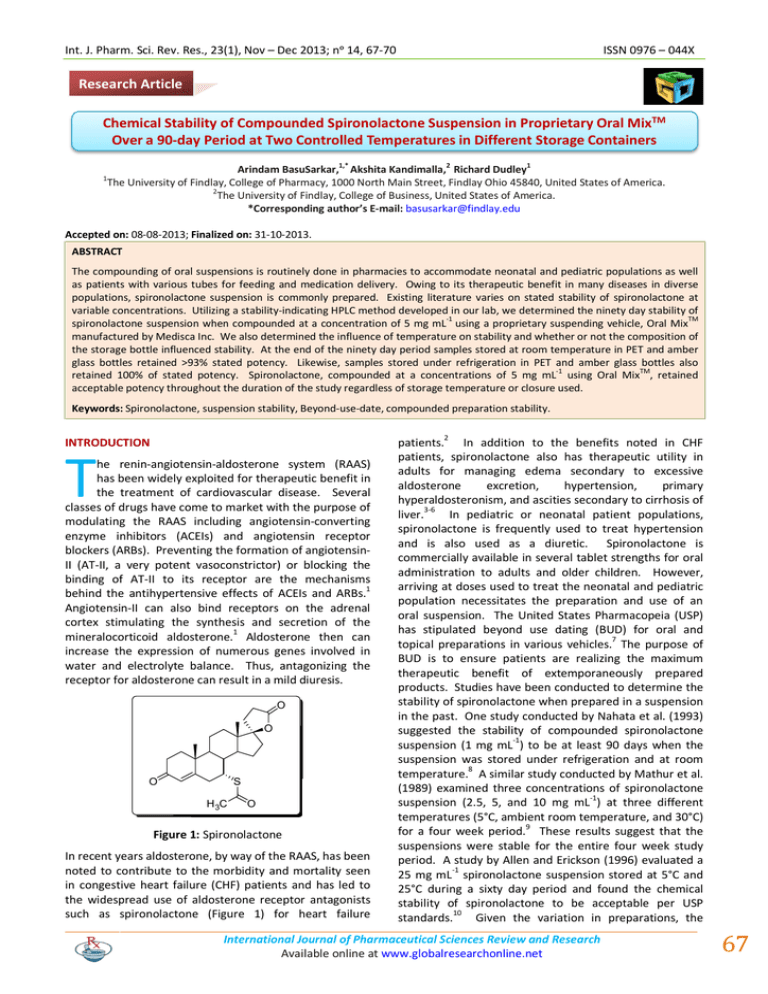
Int. J. Pharm. Sci. Rev. Res., 23(1), Nov – Dec 2013; nᵒ 14, 67-70 ISSN 0976 – 044X Research Article Chemical Stability of Compounded Spironolactone Suspension in Proprietary Oral MixTM Over a 90-day Period at Two Controlled Temperatures in Different Storage Containers 1,* 1 2 1 Arindam BasuSarkar, Akshita Kandimalla, Richard Dudley The University of Findlay, College of Pharmacy, 1000 North Main Street, Findlay Ohio 45840, United States of America. 2 The University of Findlay, College of Business, United States of America. *Corresponding author’s E-mail: basusarkar@findlay.edu Accepted on: 08-08-2013; Finalized on: 31-10-2013. ABSTRACT The compounding of oral suspensions is routinely done in pharmacies to accommodate neonatal and pediatric populations as well as patients with various tubes for feeding and medication delivery. Owing to its therapeutic benefit in many diseases in diverse populations, spironolactone suspension is commonly prepared. Existing literature varies on stated stability of spironolactone at variable concentrations. Utilizing a stability-indicating HPLC method developed in our lab, we determined the ninety day stability of -1 TM spironolactone suspension when compounded at a concentration of 5 mg mL using a proprietary suspending vehicle, Oral Mix manufactured by Medisca Inc. We also determined the influence of temperature on stability and whether or not the composition of the storage bottle influenced stability. At the end of the ninety day period samples stored at room temperature in PET and amber glass bottles retained >93% stated potency. Likewise, samples stored under refrigeration in PET and amber glass bottles also -1 TM retained 100% of stated potency. Spironolactone, compounded at a concentrations of 5 mg mL using Oral Mix , retained acceptable potency throughout the duration of the study regardless of storage temperature or closure used. Keywords: Spironolactone, suspension stability, Beyond-use-date, compounded preparation stability. INTRODUCTION T he renin-angiotensin-aldosterone system (RAAS) has been widely exploited for therapeutic benefit in the treatment of cardiovascular disease. Several classes of drugs have come to market with the purpose of modulating the RAAS including angiotensin-converting enzyme inhibitors (ACEIs) and angiotensin receptor blockers (ARBs). Preventing the formation of angiotensinII (AT-II, a very potent vasoconstrictor) or blocking the binding of AT-II to its receptor are the mechanisms behind the antihypertensive effects of ACEIs and ARBs.1 Angiotensin-II can also bind receptors on the adrenal cortex stimulating the synthesis and secretion of the mineralocorticoid aldosterone.1 Aldosterone then can increase the expression of numerous genes involved in water and electrolyte balance. Thus, antagonizing the receptor for aldosterone can result in a mild diuresis. O O O S H 3C O Figure 1: Spironolactone In recent years aldosterone, by way of the RAAS, has been noted to contribute to the morbidity and mortality seen in congestive heart failure (CHF) patients and has led to the widespread use of aldosterone receptor antagonists such as spironolactone (Figure 1) for heart failure patients.2 In addition to the benefits noted in CHF patients, spironolactone also has therapeutic utility in adults for managing edema secondary to excessive aldosterone excretion, hypertension, primary hyperaldosteronism, and ascities secondary to cirrhosis of liver.3-6 In pediatric or neonatal patient populations, spironolactone is frequently used to treat hypertension and is also used as a diuretic. Spironolactone is commercially available in several tablet strengths for oral administration to adults and older children. However, arriving at doses used to treat the neonatal and pediatric population necessitates the preparation and use of an oral suspension. The United States Pharmacopeia (USP) has stipulated beyond use dating (BUD) for oral and 7 topical preparations in various vehicles. The purpose of BUD is to ensure patients are realizing the maximum therapeutic benefit of extemporaneously prepared products. Studies have been conducted to determine the stability of spironolactone when prepared in a suspension in the past. One study conducted by Nahata et al. (1993) suggested the stability of compounded spironolactone suspension (1 mg mL-1) to be at least 90 days when the suspension was stored under refrigeration and at room 8 temperature. A similar study conducted by Mathur et al. (1989) examined three concentrations of spironolactone -1 suspension (2.5, 5, and 10 mg mL ) at three different temperatures (5°C, ambient room temperature, and 30°C) 9 for a four week period. These results suggest that the suspensions were stable for the entire four week study period. A study by Allen and Erickson (1996) evaluated a 25 mg mL-1 spironolactone suspension stored at 5°C and 25°C during a sixty day period and found the chemical stability of spironolactone to be acceptable per USP standards.10 Given the variation in preparations, the International Journal of Pharmaceutical Sciences Review and Research Available online at www.globalresearchonline.net 67 Int. J. Pharm. Sci. Rev. Res., 23(1), Nov – Dec 2013; nᵒ 14, 67-70 concentrations used, and the varied storage conditions and storage vessels, we conducted a ninety day stability study of spironolactone 5 mg mL-1 when stored at two controlled temperatures (4°C and 25°C) in both amber glass bottles and polyethylene terephthalate (PET) bottles. Our preparations were compounded using Oral MixTM, a proprietary suspending vehicle provided by Medisca Inc. MATERIALS AND METHODS Spironolactone USP was provided by Medisca Pharmaceutique Inc. Quebec, Canada. HPLC grade acetonitrile (ACN) was purchased from Fisher Scientific. Deionized water (18 Ω) was available in our lab. All other reagents used were of analytical grade. ISSN 0976 – 044X General Procedure for Preparation of Standards and Samples Primary Standard: Two hundred fifty milligrams (0.25 grams) of spironolactone was placed in a mortar with 1 TM mL of propylene glycol and triturated. Oral Base was added geometrically to afford a final concentration of 5 mg mL-1 (5000 mg mL-1). From this suspension, 1 mL was removed and subsequently diluted with 9 mL acetone to bring the concentration to 500 (mg mL-1). This dilution represented the primary standard (PS). Secondary Standards: Using the 500 mg mL-1 primary standard, dilutions were prepared to afford -1 concentrations of 25, 50, 75, and 100 mg mL which were then used to generate the standard curve. Standard Curve for Spironolactone Instruments A Hewlett Packard 1050 HPLC system consisting of a quaternary pump (Model 79852A), an autosampler (Model 79855A), a degasser (Model G1303A), a diodearray-detector (Model HP1046A), a solvent tray and a desktop computer loaded with ChemStation software was used for our analysis. A Mettler AL204 electronic balance (Mettler-Toledo, Columbus, OH) was used for standard and sample preparation. Preparation and sampling Preparations were compounded as per standard compounding procedures to afford a final spironolactone concentration of 5 mg mL-1. A glass mortar and pestle was used for compounding. Two hundred mL’s of spironolactone suspension was prepared and divided into two equal portions of 100 mL’s. This amount was further divided in amber glass and PET bottles (50 mL’s each). Each set (glass and PET bottles) were then stored at room temperature (25°C) and under refrigeration (4°C) throughout the study period. Samples were withdrawn at predetermined times of 0, 2, 7, 14, 28, 45, 60 and 90 days. A minimum of four samples were analyzed for each of the time point listed above. The analysis was performed according to a high pressure liquid chromatography (HPLC) method developed in our laboratory and described below. Sample vials were labeled and filled with approximately 2 mL of secondary standard (25, 50, 75, and 100 mg mL-1). Standards were placed in the autosampler and separation was initiated with an injection volume of 10 µL using the method previously described under Chromatographic Conditions. Each secondary standard was run in quintuplicate fashion to generate area under the curve (AUC) data. Plots of AUC versus concentration were generated for visual inspection. Linear regression analysis was performed to establish the concentration (mg mL-1) versus area under the curve relationship in quantitative terms. The relationship is expressed by the following equation: y = 18.227x – 1.9705 Where x = concentration of spironolactone (mg mL-1) and y= AUC (area under the curve for spironolactone, a dimensionless number). The correlation coefficient (R2= 0.9923) value indicates a near perfect linear fit of the data (five replicates). The standard curve is shown in Figure 2. 2000 1800 y = 18.227x + 1.9705 R² = 0.9923 1600 1400 1200 Chromatographic Conditions The mobile phase consisted of 55% acetonitrile and 45% deionized water (18Ω). The stationary phase consisted of a Zorbax Eclipse Plus Column (C18, 4.6mm ID x 150 mm, 3.5 micron particle size, 95Å pore size, pH range 2-9) (Agilent Technologies, Santa Clara, CA) and a compatible Zorbax pre-column. The column temperature was maintained at 30°C while and the flow rate was maintained at 1 mL min-1 for a run time of 10 minutes. The injection volume for each sample was 10 µL and the detection wavelength was 238 nm. 1000 800 600 400 200 0 0 20 40 60 80 100 120 Figure 2: Spironolactone Standard Curve: Area is displayed on the ordinate and concentration in (mg mL-1) on the abscissa. International Journal of Pharmaceutical Sciences Review and Research Available online at www.globalresearchonline.net 68 Int. J. Pharm. Sci. Rev. Res., 23(1), Nov – Dec 2013; nᵒ 14, 67-70 Test Sample preparation As described earlier, 1 mL of the prepared spironolactone suspension was diluted with 9 mL acetone to afford a -1 concentration of 500 µg mL . One mL of this solution is further diluted with 9 mL of acetone to get a theoretical concentration of 50 µg mL-1. Ten microliters of the sample and was injected in the HPLC. ISSN 0976 – 044X presence of 1N HCl. The chromatograms were obtained under comparable chromatographic condition. RESULTS AND DISCUSSION Spironolactone suspension (5 mg mL-1) was prepared with TM Oral Mix suspending vehicle and stored at two controlled temperatures for a ninety day period in two different vessels. Using the aforementioned HPLC method developed in our lab, we successfully separated spironolactone from the chromophores contained in Oral TM Mix and were able to determine the ninety day stability of spironolactone in the vehicle. When analyzed at each time point during the study (day 0, 2, 7, 14, 28, 45, 60, and 90) the active pharmaceutical ingredient was deemed chemically stable within the threshold of ± 10% for stated potency, acceptable per USP standards. In fact, our data suggests that regardless of closure used (PET or amber glass), and regardless of temperature, spironolactone retained chemical stability in the amount of 93% for the 25°C PET arm and 100% chemical stability was retained for the 4°C PET and amber glass closure as well as the 25°C amber glass closure for the entire ninety day study period (Table 1). Figure 3: Representative chromatograms showing pure spironolactone (blue) and the acid-degraded spironolactone (red) peaks. Parent spironolactone quickly degraded in the Table 1: Stability data from key time points for Spironolactone 5 mg mL-1 suspension compounded in Oral MixTM Day Day 28 Day 28 Day 60 Day 60 Day 90 Day 90 0 at 25⁰C at 4⁰C at 25⁰C at 4⁰C at 25⁰C at 4⁰C 96.7 98.3 99.4 93.1 99.7 93.3 100.4 4 4 4 4 4 4 4 Coefficient of Variation (% of Mean) 2.14 1.32 1.17 1.41 0.6 3.22 1 Mean API (% of Labeled Amount) 97.3 99.9 99.1 91.4 95.25 100.1 104.1 4 4 4 4 4 4 4 3.47 2.37 1.24 1.9 3.4 5.16 1.71 Preparation name -1 Spironolactone 5 mg mL Stored in PET Closure -1 Spironolactone 5 mg mL Stored in Amber Glass Mean API (% of Labeled Amount) Number of replicates Number of replicates Coefficient of Variation (% of Mean) Considering the structure of spironolactone, the presence of a lactone (cyclic ester) and a thioester bond suggests areas of instability when exposed to water. Additionally, the presence of acid or base could expedite a hydrolytic reaction. This is somewhat concerning given the weakly TM acidic nature of Oral Mix suspending vehicle used in this study. Interestingly though, we were unable to detect any influence of the weakly acidic vehicle on the chemical stability of spironolactone. To determine if spironolactone was indeed acid-labile, a sample of pure spironolactone was mixed with 1 N HCl and analyzed after only 30 minutes at room temperature. The chromatogram shown in Figure 3 shows the peak of the parent molecule diminishing and a new peak, the degradation product, occurring at before the spironolactone peak. It is clear to us that acid can hasten the breakdown of spironolactone into a species with a shorter retention time. At present we are working to determine the identity of this breakdown product. The true clinical effect of lactone hydrolysis or cleavage of the thioester prior to administration to the patient is an interesting discussion point. Both reactions do occur in vivo after oral administration (the thioester bond in fact is removed and the steroid ring system oxidizes to afford canrenone, an active metabolite, and the lactone opens to afford canrenoic acid).11 We expected to detect degradation products using our HPLC method if formed, however given that > 93% of initial drug concentration is retained in all samples at the ninety day analysis point we are reluctant to believe that breakdown products are formed. Utilizing Oral MixTM suspending vehicle for the compounding of spironolactone afforded a suspension stable for a 3 month period. International Journal of Pharmaceutical Sciences Review and Research Available online at www.globalresearchonline.net 69 Int. J. Pharm. Sci. Rev. Res., 23(1), Nov – Dec 2013; nᵒ 14, 67-70 7. Brunton LL, Chabner BA, Knollmann BC. Goodman and th Gilman's The Pharmacological Basis of Therapeutics 12 Edition, 2011, 1221-1222. United States Pharmacopeia and National Formulary (USP th 30-NF25) Rockville, MD 2007; 1(27 ed.). 8. Pitt B, Zannad F, Remme WJ, Cody R, Castaigne A, Perez A, Palensky J, Wittes J, The effect of spironolactone on morbidity and mortality in patients with severe heart failure. Randomized Aldactone Evaluation Study Investigators, N Engl J Med, 341(10), 1999, 709-17. Nahata MC, Morosco RS, Hipple TF, Stability of spironolactone in an extemporaneously prepared suspension at two temperatures, Ann Pharmacother, 27(10), 1993, 1198-9. 9. Mathur LK, Wickman A. Stability of extemporaneously compounded spironolactone suspensions, Am J Hosp Pharm, 46(10), 1989, 2040-2. REFERENCES 1. 2. ISSN 0976 – 044X 3. Biecker E, Diagnosis and therapy of ascites in liver cirrhosis. World J Gastroenterol, 17(10), 2011, 1237-48. 4. Ernst ME, Moser M. Use of Diuretics in Patients with Hypertension, N Engl J Med, 361, 2009, 2153-2164. 5. Schrier RW, Masoumi A, Elhassan E, Aldosterone: role in edematous disorders, hypertension, chronic renal failure, and metabolic syndrome, Clin J Am Soc Nephrol, 5(6), 2010, 1132-40. 6. Skluth HA, Gums JG. Spironolactone: a re-examination, Dicp, 24(1), 1990, 52-9. 10. Allen LV, Jr., Erickson MA, Stability of ketoconazole, metolazone, metronidazole, procainamide hydrochloride, and spironolactone in extemporaneously compounded oral liquids, Am J Health Syst Pharm, 53(17), 1996, 2073-8. 11. Los LE, Pitzenberger SM, Ramjit HG, Coddington AB, Colby HD, Hepatic metabolism of spironolactone. Production of 3-hydroxy-thiomethyl metabolites. Drug Metab Dispos, 22(6), 1994, 903-8. Source of Support: Nil, Conflict of Interest: None. International Journal of Pharmaceutical Sciences Review and Research Available online at www.globalresearchonline.net 70
